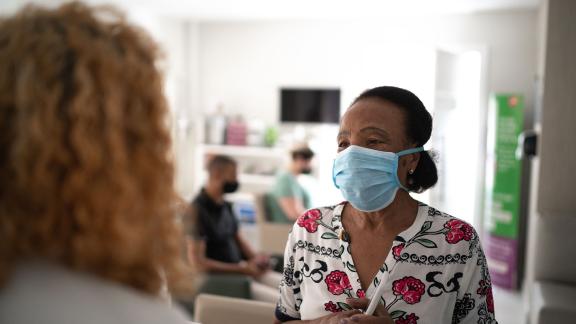Is it impossible to see a GP?

Overview
“You can’t get a GP appointment” has become a common refrain for the public and political parties across the spectrum. For many, general practice is the ‘gatekeeper’ of the NHS and the first port of call for non-emergency care – not being able to get an appointment is a serious concern.
For patients and staff, the current challenges in GP access are viewed as a crisis fuelled by rising demand, variation in resources and provision, and mismatched expectations. In spite of the perception of the crisis, there are reasons to be positive and it is important to recognise the ongoing steps towards improvement that those working within general practice have made. A year on from the Primary Care Access Recovery Plan, the situation is not resolved, but the impact of changes can be assessed. This piece explores what’s happened to appointment numbers, and if it really is impossible to see a GP.
Where does the myth begin?
The number of fully-qualified permanent GPs has been falling since 2015 but the current access crisis has its roots in the COVID-19 pandemic. When lockdown was announced, many practices paused all but essential face-to-face appointments, migrating to virtual and telephone consultations. Despite these alternative ways to see a doctor fewer appointments were available due to resources being redeployed to help manage the pandemic response, particularly the vaccination programme. The narrative quickly emerged that general practice was closing its doors to patients, and this impression has lingered long after lockdown.
But is it accurate?
Exploring the evidence
It is true that patient experience of access to general practice has declined in recent years, and that in 2023, 2.8 million people each month struggled to contact a GP practice. Since 2015 GP numbers have been in decline, while patient list sizes have grown annually.
There were 29,364 fully-qualified full-time GPs in England in September 2015 when the then health secretary promised to increase numbers of full-time GPs by 5,000 by 2020. This target was missed, but numbers have slowly begun to recover, rising by 268 to 27,574 between March 2023 and March 2024.
However, in spite of the small recovery, recruitment and retention remain significant challenges, and the ratio of GPs to patients remains lower than in 2015. When comparing census data, we can see that in 2015, there was one GP to every 1,867 patients, and in 2022, there was one GP to every 2,071 patients.
It is therefore no surprise that practices have struggled to meet the growth in demand and recover from the COVID-19 pandemic. This situation has led to a decrease in patient satisfaction with access.
Appointments did decline when the pandemic began in 2020 with services reprioritised, staff illness and burnout rising dramatically, alongside resources being redeployed to deliver the vaccination programme. However, despite negative perceptions, the number of appointments delivered in general practice have increased every year since 2021. Moreover, by October 2023 general practice delivered almost 50 million more appointments than the same period in 2019. Yet, the negative narrative lingers.
Why does the negativity persist?
As access to healthcare remains a priority concern for the public, the media and political discourse has continued to be dominated by GP access, including the availability of face-to-face appointments and same-day access.
To address access challenges, the government continues to incentivise access and face-to-face appointments as a priority in spite of research which found that more than 70 per cent of patients prefer the choice to have virtual appointments. Moreover, as same-day access is prioritised, fewer routine appointments are available as more appointments are held for urgent and same-day booking. This leads to long waiting times for routine GP appointments and has led to the, now familiar, ‘8am scramble’ for a same-day appointment, which can leave many patients frustrated and fuels the public perception that appointments are not available.
While there is still a large amount of unmet demand, in March 2024, 43.9 per cent of appointments were delivered on the day of booking, and 65 per cent were delivered face to face. The number of same-day and face-to-face appointments has grown since the pandemic, but other factors have led to patients experiencing unsatisfactory access.
While appointment numbers have risen nationally, there is still significant regional variation in capacity. This variation means that in some areas patients are at a greater disadvantage when accessing necessary services. Where the level of improvement falls behind that seen nationally, patients are experiencing greater inequity of access and potentially variation in the type of service available.
While access has increased, not every appointment is delivered by a GP. As part of improving access to general practice, the Additional Roles Reimbursement Scheme (ARRS) was launched in 2019 through newly formed PCNs, offering general practice the opportunity to recruit new staff to provide additional services. Over 34,000 ARRS staff have been recruited since 2019, offering patients access to specialised roles such as mental health practitioners, social prescribers, and physiotherapists, which have not previously been available in primary care. These professionals, alongside existing practice nurses and GPs, have played a key role in delivering the target 50 million more appointments, but this has not been effectively communicated to the public in many parts of the country. Moreover, with the launch of Pharmacy First, which enables community pharmacists to complete episodes of care for patients without GP intervention, the GP is no longer the first point of contact for every patient.
The new staff and pathways have been introduced to primary care to see patients who would be best served by an alternative practitioner, freeing up GP time for patients with more complex needs, who require a GP intervention.
It has been a challenge to move on from a ‘GP first’ model of primary care, to the GP-led team model, and some patients are unhappy with appointments provided by other practitioners. Negative feedback from patients who prefer GP appointments has been highlighted in public and political discussions around access challenges and contributed to the narrative that patients cannot see a GP. However, GP appointments are still available when clinically necessary.
Each political party has committed to improving access to GP appointments, but the narrative continues to present access as a singular issue, rather than the outcome of contributing factors like workforce, estates, and increasing demand and complexity which is challenging the effectiveness of ten-minute appointments. While the focus remains on access alone and on the amount of unmet demand, it is difficult to celebrate the success of delivering more appointments or recognise the ongoing neglect of the factors which most influence access.
The bottom line
Ultimately, primary care has been working incredibly hard to meet increased need and has recruited new staff, introduced virtual appointments, and developed enhanced access services. This has successfully increased the appointments available to patients beyond pre-pandemic levels. However, challenges remain – most notably with GP numbers continuing to fall, lack of capital investment into estates and the currently universal pressure on the healthcare workforce. Primary care is delivering more appointments than ever, but demand is rapidly outpacing capacity.
Our vision for the future of primary care, including sustainable improvement in access, can be found in our report: Empowered, Connected and Respected: a Vision for General Practice at Scale and Primary Care Networks.
Read more from our series of explainers, providing facts and figures to challenge common misconceptions in health and care.



